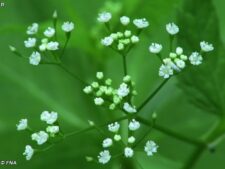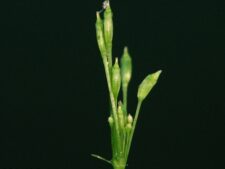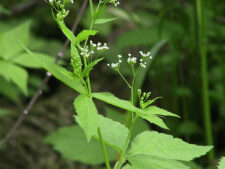
HONEWORT
Cryptotaenia canadensis
PARSLEY FAMILY (Apiaceae)
 Identification
Identification
- Flowering time - Late May, June, July
- Common in floodplain and upland woods at both FF and NW
- Loose clusters (umbels) of tiny flowers with 5 petals
- Leaves in groups of 3 leaflets; larger outer leaflets often lobed
- For differentiation from other Parsley Family members with tiny white flowers see Comments.
This native perennial stands erect up to 3 feet tall. Stems and leaves are smooth and hairless (D). The leaves are up to 6 inches long and divided into 3 toothed leaflets. Upper leaflets are unlobed (D) but the outer leaflets of the larger lower ones are often deeply lobed (A). The tiny white flowers are arranged in loose clusters (compound umbels) above the leaves (B). A closer look will reveal each cluster is composed of several smaller clusters (umbellets); each umbellet has a few tiny 5-petaled white flowers. The fruit is encased in a narrow, beaked, ribbed capsule (C) 1/4 inch long. It is initially green but turns black as it matures.
Flowering occurs in Late May, June and July. Honewort is most common in floodplain woodlands and hollows at both Fontenelle Forest and Neale Woods. It is present, but less common in the upland woods.
Honewort could be confused with other Parsley Family members flowering at the same time, Aniseroot (Osmorhiza longistylis) and Sweet Cicely (Osmorhiza claytonii) which also have umbels of tiny white flowers, leaves divided into 3 leaflets and narrow, ridged seed capsules. Honewort is the only one with lobed outer leaflets and hairless stems and leaves.
The content of NatureSearch is provided by dedicated volunteer Naturalists of Fontenelle Forest who strive to provide the most accurate information available. Contributors of the images retain their copyrights. The point of contact for this page is: Roland Barth.



